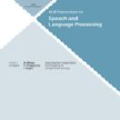In this paper, we analyze the error floor of quasi-cyclic (QC) low-density parity-check (LDPC) codes decoded by the sum-product algorithm (SPA) with row layered message-passing scheduling. For this, we develop a linear state-space model of trapping sets (TSs) which incorporates the layered nature of scheduling. We demonstrate that the contribution of each TS to the error floor is not only a function of the topology of the TS, but also depends on the row layers in which different check nodes of the TS are located. This information, referred to as TS layer profile (TSLP), plays an important role in the harmfulness of a TS. As a result, the harmfulness of a TS in particular, and the error floor of the code in general, can significantly change by changing the order in which the information of different layers, corresponding to different row blocks of the parity-check matrix, is updated. We also study the problem of finding a layer ordering that minimizes the error floor, and obtain row layered decoders with error floor significantly lower than that of their flooding counterparts. As part of our analysis, we make connections between the parameters of the state-space model for a row layered schedule and those of the flooding schedule. Simulation results are presented to show the accuracy of analytical error floor estimates.
翻译:在本文中,我们分析了由产品总算(SPA)和分层传递信件的排层排程表解码的准周期(QC)低密度对等检查(LDPC)代码的错误底层。 为此,我们开发了一个包含排层排程特性的陷阱套件(TS)线性状态空间模型(TS),该模型将包含排程表的分层性质。我们证明,每个TS对差底层的贡献不仅是TS的地形学函数,而且还取决于各行层中存在不同检查节点的列层。这种信息被称为TS层剖面图(TSLP),在TS的有害性方面起着重要作用。因此,一个TS特别是代码的有害性以及一般误差底层模型可以通过改变不同层中的信息的顺序而发生重大变化。我们还研究了如何找到一个层层组来尽可能减少TSTS的错误底部节点,并获得带有错误层层层层层层中错误的层层层图解,从而得出了我们所处的表层层层层层层中测测算的模型的模型的模型,从而展示了对洪水的模型的模型的进度的进度对比。 我们展示了这些模型的进度对比,显示了了模型的进度对比。




